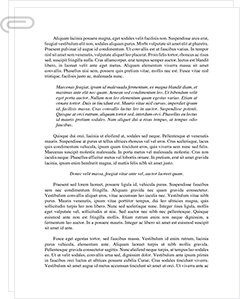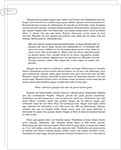 Study Document
Study Document
ELL Analysis English Language Learning Essay
Pages:5 (1548 words)
Sources:2
Subject:Communication
Topic:English Language Learners
Document Type:Essay
Document:#17188549
The first example is her sentence structure. The sentences are complete but simple. For example she wrote, "The boy is mopping." It is clear that this student understands how to combine words and punctuation to form sentences but the words used are basic vocabulary and the sentence is using only introductory English words. The second example of her emerging level is her vocabulary. In one sentence she wrote, "The girl is folding." This is the most basic a statement can be, there is a name, a verb, and a verbal. All the words are simple English words. This is common for an early production language learner. The final example of her basic level is one that separates her from a speech emergence student: variation. The student only has the most basic grasp of the language, so she is only able to form basic sentences, all with the same structure and limited usage and vocabulary.
This student needs nothing more than continuous assistance. I would continue giving this student worksheets and may begin encouraging oral storytelling as well. Finally, I would give the student pictorial flashcards to improve overall vocabulary.
Works Cited
Haynes, Judy (2005). Stages of Second Language Acquisition. Everything ESL. Available at http://www.everythingesl.net/inservices/language_stages.php.
Hill, Jane & Flynn Kathleen (2009). Classroom Instruction that Works With English Language Learners. Nebraska ELLLI Design Team. Available at http://www.education.ne.gov/NATLORIGIN/PDF/Classroom%20Instructions/Study_Guide_2009.pdf
Sample Source(s) Used
Works Cited
Haynes, Judy (2005). Stages of Second Language Acquisition. Everything ESL. Available at http://www.everythingesl.net/inservices/language_stages.php.
Hill, Jane & Flynn Kathleen (2009). Classroom Instruction that Works With English Language Learners. Nebraska ELLLI Design Team. Available at http://www.education.ne.gov/NATLORIGIN/PDF/Classroom%20Instructions/Study_Guide_2009.pdf
Related Documents
 Study Document
Study Document
Language Development Chart
English Language Learning (Native Speakers) Stage/Age Language Overall Phonology Morphology Syntax Semantics Implications on reading and writing Practical Approaches Birth -3 mo. Cries, responds to tone, attentive to special sounds, and begins to vocalize. Reflexive and diverse cries, coos and gurgles. Verbal play, some consonants, laughing. No understanding Sounds or intensity as opposed to meaning. Music and talk to child Double syllables, MAMA, tunefully vocalize Vocalizes pleasure and pain; initiates speech, reproduces babbles. Increased sounds and imitation Very little understanding Truck red; hungry eat, etc. Use of words and instructi8ons, jargon
 Study Document
Study Document
ELL Language Acquisition in English
First, Spanish sounds different from English in terms of vowel sounds, sentence stress, and timing. (Shoebottom, 2007, Spanish). In addition, Spanish speakers can confront grammar problems when learning English, "although Spanish is a much more heavily inflected language than English, there are many aspects of verb grammar that are similar. The major problem for the Spanish learner is that there is no one-to-one correspondence in the use of the
 Study Document
Study Document
English-Language Dramas and Soap Operas
The long-term effects of such learning suggest that language skills and vocabulary are also retained longer when learned in a context other than pure ESL instruction (Song 2006). Both quantitative and qualitative data will be collected and analyzed as a part of this research study. Questionnaires with both closed and open response sections will be developed independently for students and ESL instructors, and administered electronically to those involved both in
 Study Document
Study Document
English Language Learner Experiences
ELL Case Study: JavierPart 1Javier (a pseudonym to protect his identity) is a 17-year-old student in the 12th grade, attending a high school in a medium-sized town in the Midwest. Born and raised in Mexico, Javier\\\'s journey to the United States began four years ago, and it marked a major transition in his life and education.Background and Family LifeJavier comes from a close-knit family and is the youngest of three
 Study Document
Study Document
Language Learning and Language
Perfect When it comes to present perfect, it is important to note that the tenses of verbs and the specificity via which a prior event is describe is pivotal. Indeed, under the present perfect paradigm, it is important to use the words "has" or "have" but one would not be more specific than that when it comes to the timing of the event as that would be outside the present
 Study Document
Study Document
Obstacles to Language Learning in the Classroom
ELLs: Identification and Intervention Why the Overrepresentation of ELLs in the Classroom Artiles, Rueda, Salazar and Higareda (2005) state that ELLs are overrepresented in the classroom because of a "tendency to overestimate the homogeneity of populations by failing to disaggregate factors such as language proficiency or to consider social class or program type" (p. 283). In other words, administrators and teachers are not recognizing diversity enough in the schools and are therefore



